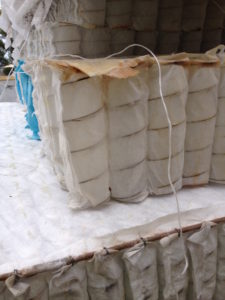'individually wrapped springs are difficult to process'

We generally change mattresses every 10 years. In WA new mattresses are usually made in the state as transporting the made product would be too bulky and costly.
So what can be done with old mattresses in Australia? In 2009 in NSW, Mission Australia, a large charity with clothing collection bins, was getting a huge number of old mattresses dumped next to the bins. The cost of disposing of these items was enormous. Reuse is tricky due to unknown history, bed bugs and general contamination possibilities. Could they actually be recycled?
Yes, although the profit margin is small and not all of the materials can currently be utilised. In 2015 in Perth WA, there was some mattress recycling but the processors were overwhelmed by both quantity and processing.
A social enterprise called Soft Landing responded to the situation in January 2016. Soft Landing part of the Great Lakes Community Resources Inc. based in NSW, opened a collection and processing plant in Wangara, Perth. They collect mattresses from tip sites, transfer stations, mattress sellers, verge collections and residences. In 2016 Soft Landing collected and processed 31,500 mattresses.
The mattresses are stripped of the outer layer, usually a synthetic wadding, and the foam layer underneath is taken off and baled up. The foam is taken to Dunlop in Victoria and used in carpet underlay. The spring base is loaded into a heavy duty compactor and the metal squashed into 90kgm bales. These are taken by a metal recycler and sent off shore for reprocessing.

mattress cover is stripped and discarded

foam is baled and sent to Eastern States
to process into carpet underlay

7 to 8 springs are compressed
into each bale.
Not all mattresses are simple. The individually wrapped springs, so enthusiastically promoted by retailers for improved comfort etc, become a difficult item to recycle. The wrapping around each spring is difficult and time consuming to extract resulting in an inferior metal product for market.

Individually wrapped springs are
difficult to process.

An inferior metal product from
individually wrapped springs.
A latex mattress, while made from ‘natural’ materials (rubber), is heavy and not well liked by the foam recyclers.

Latex mattresses are heavy and
have a limited recycling market.
A good mattress for recycling will have a thin outer layer, (one company even has a zip on this outer layer), one piece of inner foam and the layer of metal springs. 95% of this mattress design can be recycled.
Both mattresses and bases are accepted by Soft Landing. The bases when cut from the outer material layer, have the based stripped by a metal slicing machine, giving a clean wood frame residue. The wood is sent to a local wood processor for mulching and sawdust. The sawdust is used in chicken farms for deep litter.

Older mattresses will contain a wadding of material and fluff, while others may have kapok and coconut fibre. Currently all of the outer layers and material inserts are being landfilled. Research is underway to find a use for these materials.
The real conversation must be with all parties- manufacturers, retailers, customers, recyclers and waste management bodies. There is discussion with some manufacturers in the Eastern States to establish a product stewardship scheme whereby manufacturers will be responsible for the processing of the end product. There is a law in Australia called The Product Stewardship Act 2011 whereby manufacturers, importers and some users will be liable for the safe ‘disposal’ or final destiny of their products.
TV’s and computers have been the first goods where this is applied under a voluntary scheme called the National Televison and Computer Recycling Scheme
Other products being considered include batteries, mattresses and tyres- all tricky combinations of many difficult materials but all plentiful and often problematic to dispose.






